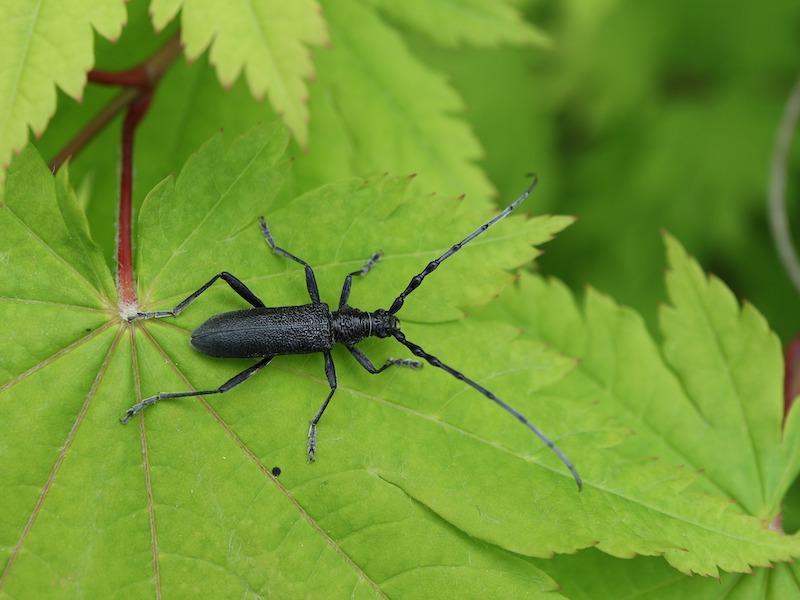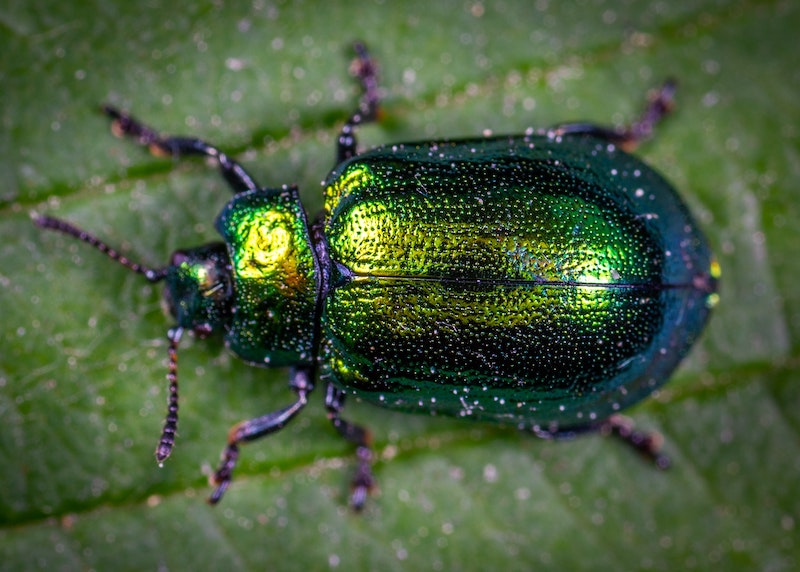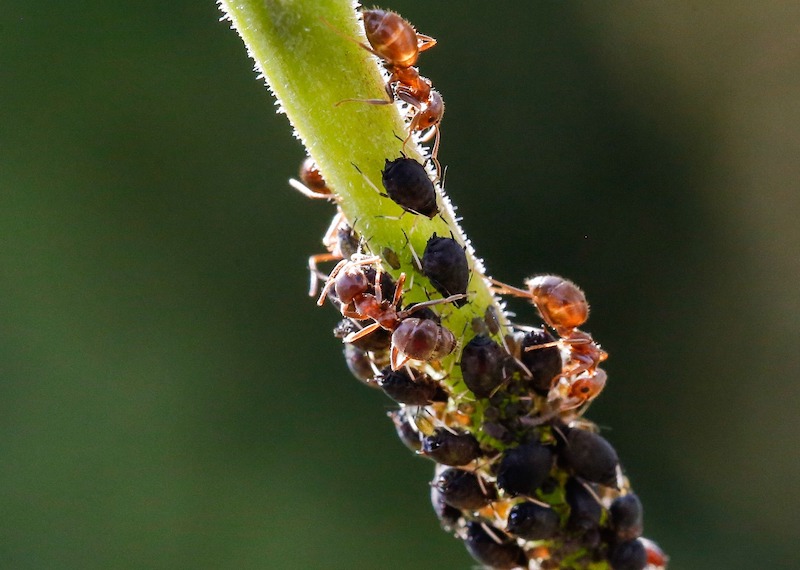Japanese maples are beloved landscape trees prized for their diversity in foliage and form. Also known as Acer palmatum, these versatile trees are native to regions in Asia and are cultivated in temperate regions around the world. An excellent plant for low-maintenance gardens, Japanese maples are easy to care for and are relatively pest-free.
The pests that do affect Japanese maples are mostly cosmetic in concern and usually do not affect the health of the tree. The most common pests of Japanese maples are scale, Japanese beetles, and aphids. This article will cover the ways to identify these pests on Japanese maples in addition to methods of control and prevention.

Common Japanese Maple Pests
Scale
There are several species of scale, some of which infest Japanese maples. One of the most common scale insects of Japanese maples is the aptly named Japanese scale, Lopholeucaspis japonica. This pest is a small, ovular insect that is brown in color. Adults are stationary for most of their lives and can be found in clusters on branches.
Often, a white waxy substance is produced around scale insects. These pests use their piercing-sucking mouthparts to feed on the sap in the phloem of Japanese maples and other plants. While rarely fatal to the plant, stunted growth and canopy dieback are common in severe infestations.
Treating Scale on Japanese Maples
Prune off any branches that are severely infested with scale. For less severe infestations, scrape the pests off using a brush - just be careful to not damage the tree’s bark. Apply systemic insecticides to the soil during the crawler stage of this insect’s life. Crawlers are the mobile nymphs of scale insects. Multiple applications may be needed, as crawlers emerge in waves from mid-spring through summer. Insect growth regulators may also be effective. Do not use neem or horticultural oils on Japanese maples, as these oils are phytotoxic to Japanese maples and may cause additional damage to the plant.
Preventing Scale on Japanese Maples
Applying too much fertilizer can result in bursts of fresh growth that are more appealing to scale insects. Fertilize your Japanese maples just once per year in early spring, and less if the soil is rich in organic matter. Reduce sources of stress to the plant by planting it in an appropriate location and watering well during drought periods.
Monitor your Japanese maples regularly for signs of scale, particularly on younger and newly planted trees. Provide habitat for beneficial insects, such as parasitoid wasps, by planting a variety of trees, shrubs, and herbaceous plants, particularly those that are native to your region.
Japanese Beetles
Japanese beetles, Popillia japonica, are common pests of landscape plants, including Japanese maples. These medium-sized, copper and green beetles are seen in summer after pupation in the soil. The larvae are creamy white grubs with rust-colored heads that feed on the roots of grasses.
Adults damage Japanese maples by feeding on their leaves. Look for the characteristic lace-like damage on the leaf tissue surrounding the veins. Often, a large number of Japanese beetles can be seen congregating on a single branch, as chemicals released during feeding attract Japanese beetles from afar. Japanese beetles are very unlikely to kill a healthy Japanese maple.

Treating Japanese Beetles on Japanese Maples
Hand-picking and dumping the beetles into a container of soapy water is often enough to control these pests, as the damage they do is mostly aesthetic. Japanese beetles are easier to catch in the morning or evening. Check daily to be sure that your yard is free of these insects. Remove any damaged leaves.
If the infestation is severe and unmanageable, chemical controls may be warranted. Opt for organic pesticides that do not harm pollinators. Bacillus thuringiensis galleriae, a biocontrol, can also be somewhat successful on Japanese beetles. Treating the grubs is not effective since the emerging adults travel long distances from the ground they pupate in.
Preventing Japanese Beetles on Japanese Maples
There are several Japanese beetle traps that work by releasing pheromones to lure and trap the beetles. These traps may do more harm than good, as they can inadvertently attract more Japanese beetles to your plants to feed. Avoid using Japanese beetle traps to prevent an influx of these unwanted pests. Instead, cover your Japanese maples and other at-risk plants with fine netting or sheer cloth. This will prevent the beetles from slipping through and feeding on the leaves. Japanese beetles and grubs are also tasty snacks for birds. Invite insectivorous birds to your yard with plenty of plant cover, food, and water sources.
Aphids
Aphids are familiar pests of Japanese maples and several other landscape plants. These tiny, soft-bodied insects are usually green, gray, or brown in color, and suck the sap from the vascular system of Japanese maples. Severe infestations of aphids can result in curled, discolored, and stunted growth at the ends of branches and twigs.
Aphids also secrete honeydew, a sugary substance that may lead to the development of sooty mold. Sooty mold is a gray-to-black fungus that coats the bark, leaves, and branches of Japanese maples. Although not fatal to the tree, it is extremely unsightly. You may often see ants tending to the aphids, as the ants feed on the honeydew.

Treating Aphids on Japanese Maples
Prune out any branches with large populations of aphids. A hose can also be used to spray these insects off of the tree since they do not have a strong grip. Monitor your Japanese maple for signs of aphids early and often, as it is easier to control them when their populations are small. Aphid damage is almost never fatal to Japanese maples, so chemical control is not necessary.
Although horticultural and neem oils provide good control for aphids, applying them to Japanese maples can damage the tree. Mechanical controls will suffice for treating aphids on Japanese maples. Honeydew and sooty mold can be removed with a hose or dish detergent.
Preventing Aphids on Japanese Maples
Similar to their scale relatives, aphids prefer to feed on fresh, new growth. Avoid over-fertilizing your Japanese maples to prevent an abundance of weaker growth. Ensure that your Japanese maple is healthy by providing it with proper levels of water, light, and winter care. Encourage natural predators of aphids to visit your yard by providing a diverse habitat with plenty of plants and food sources. Ladybugs, parasitoid wasps, and lacewings are all predators of aphids. Do not use harmful, bioaccumulating pesticides that may kill beneficial insects.
Japanese Maple Pests Chart
|
Pest |
Identifying |
Treating |
|
Scale |
Small, ovular insect, brown in color |
Prune off any branches that are severely infested, apply systematic insecticides |
|
Japanese Beetles |
Medium-sized, copper and green beetles, larvae are creamy white grubs with rust-colored heads |
Hand-pick and dump the beetles into a container of soapy water |
|
Pine Scale |
Small lump with abundance of white waxy substance for protection |
Prune out and destroy any scale-infested branches |
|
Aphids |
Tiny, soft-bodied insects are usually green, gray, or brown in color |
Prune out any branches with large populations of aphids, spray water through a hose |
Sources:
"Maple—Acer spp." University of California Integrated Pest Management. ipm.ucanr.edu
"Maple (Acer)." Connecticut State - The Connecticut Agricultural Experiment Station. portal.ct.gov
 |
Lauren Youngcourt - Published 05-01-2023 |
